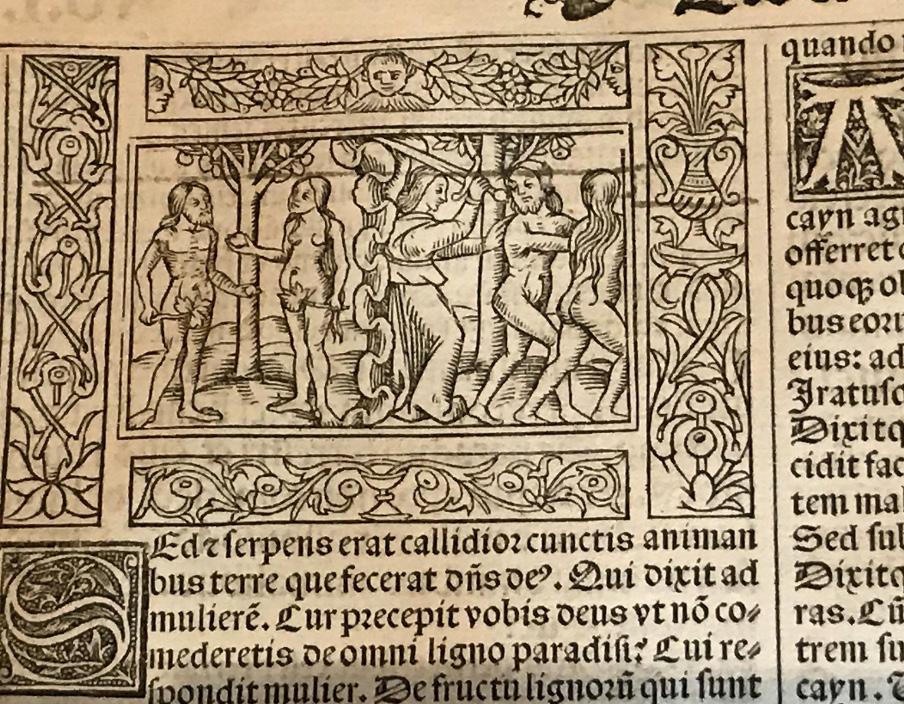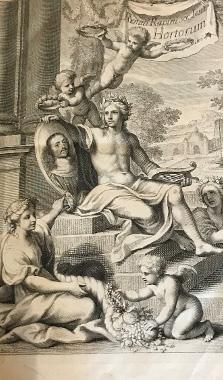
5 minute read
Aularian Ecology
James Howarth is responsible for maintaining and developing the Library’s collection, including the Hall’s historic and special collections that live in the 17th century Old Library. James is keen to promote their use in research, study and outreach.
Early ecologists in the Old Library
“What will success look like in 10 years?” asks the final section of Teddy Hall’s 10-year Strategy. One key goal for the Hall is ecological, that “St Edmund Hall [is] recognised as the greenest and most environmentally sustainable college in Oxford.”
The living wall installed last year is a first step forward in this journey to ‘green the Hall,’ but we have a history that stretches back hundreds of years. What can the books in the Old Library tell us about how previous generations of Aularian scholars have thought about the environment and nature?
‘In the beginning God created Heaven and Earth’: The influence of the Bible.
1531.
For most writers and thinkers in the Early Modern period, one book – the Bible – formed the basis of their conception of the relation between humanity and the natural world. In particular, three events in the book of Genesis shaped much thinking before the scientific revolution. Firstly, that when God created humans, he had given them mastery over the whole of nature to be used according to their needs. In the words of the King James Bible (Hall Principal John Aglionby was one of the translators for the Authorised version, although he worked on the New Testament). “And the Lord God said, Let us make man in our image, and after our likeness: and let them have dominion over the fish of the sea, and over the fowl of the air, and over the cattle and
Secondly, that before the Fall, humanity had lived in an idyllic state of harmony with all creatures that had been ended when they were expelled from the Garden of Eden. In the oldest Bible in the collection, a Latin Vulgate Bible printed in Lyons in 1531, the lush, paradisal nature of Eden is reinforced by elaborate floral decorations that surround a wood cut of Angel with a sword driving Adam and Eve from the garden.
Finally, the story of Noah and the ark offered a vision of ecological collapse. The illustration of the flood in the Library’s copy of Robert Estienne’s 1560 French translation of the Bible show ruined cities in the background, while in the foreground drowning figures flail around a rather oddly shaped ark.
Ex dono illustrissimæ Heroinæ Authoris: Margaret Cavendish’s phancies
Even as increasing scientific curiosity and discovery revealed undreamt of complexity in the natural world, as shown in the microscopic vistas of the Robert Hooke’s Micrographia (London, 1665), in some respects the biblical model endured. The natural world was described, anatomised, experimented on by mankind, exploited by man. A different note is struck in two works in the Old Library by Margaret Cavendish (1623-1673). In Poems, and Phancies and Philosophical Letters (both London, 1664) she rejects the mechanistic and mechanical model of contemporary experimental philosophy for a more holistic vision of nature as single organism in which humanity participates. Cavendish, a trailblazing writer of poems, plays and even science fiction, was also the first woman to attend a meeting of the Royal Society in May 1667.
The books are the earliest by a woman author in our collection, but also some of the first books we know the Hall to have possessed. Donated in 1664 by their author, they have been here longer than the Old Library itself.
Cavendish, the wife of the influential and fabulously wealthy Duke of Newcastle, donated copies of all her works to the colleges of Oxford and Cambridge. Not everyone in the universities was impressed, and satirical annotations are found in some copies. However, a fulsome letter of thanks from our Principal, Thomas Tully, a keen seeker of patronage for the Hall, was later published praising the Duke and Duchess.
‘The glory of God, and the advantage of society’: Advice on gardens
Something that has surprised me about the collection in the Old Library is that it contains a number of works devoted to gardens and gardening. These include the Hortorum libri quattuor or Four books on the Garden (Paris, 1665) an elaborate poetic account of the grand court gardens of 17th century France by a Jesuit priest named René Rapin (1621-1687). Our copy has an intricate binding with the French Royal arms in gold suggesting that it was a presentation copy given to a courtier. More practical are the Gardener’s Dictionary (London, 1734) and Gardeners’ Kalendar (London, 1735) of Phillip Miller (1691-1771), which are full of advice and hints on “cultivating and improving the kitchen, fruit, and flowergarden, as also the physic-garden, wilderness, conservatory, and vineyard.” As I write this on the first day of April, Miller suggests tasks for the Kitchen Garden:
“In the beginning of the this month make ridges for Melons and Cucumbers, to be cover’d with bell or hand-glasses…”
However, the wonderfully titled An essay on planting, and a scheme for making it conducive to the glory of God, and the advantage of society (Oxford, 1758) offers a more thoroughgoing environmental scheme. Written by the Aularian William Hanbury (1725-1778, mat. 1745), it outlines a scheme for a large-scale tree plantation, the proceeds of which would fund philanthropic works in his parish and the wood would be used by the Royal Navy. The plan is ambitious - Hanbury hoped to fund a huge library, a hospital and even a college - but it was also practical and moral: he stresses the benefits of the scheme for the land, the nation and also those who would work on it. The scheme never reached the heights Hanbury hoped, he repeatedly clashed with the other trustees and the scheme petered out in the 19th century.
Undoubtedly the Hall’s efforts will meet with more success!
Gardener’s Dictionary (London, 1734)













